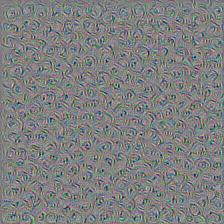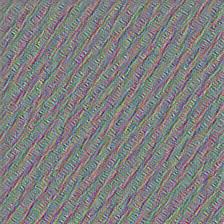机器学习: DeepDreaming with TensorFlow (一)
在TensorFlow 的官网上,有一个很有趣的教程,就是用 TensorFlow 以及训练好的深度卷积神经(GoogleNet)网络去生成一些有趣的pattern,通过这些pattern,可以更加深入的去了解神经网络到底学到了什么, 这个教程有四个主要部分:
1:简单的单通道纹理pattern的生成;
2:利用tiled computation 生成高分辨率图像;
3:利用 Laplacian Pyramid Gradient Normalization 生成各种有趣的视觉效果;
4:生成类似 Deepdream的图像;
这个教程还提供了一个生成pattern的图像库,
http://storage.googleapis.com/deepdream/visualz/tensorflow_inception/index.html
在这个库里,可以看到神经网络每一层上生成的pattern。
在学习这个教程之前,请确保你已经安装好了Tensorflow 以及 Jupyter.
这个教程里的所有pattern都是基于训练好的Googlenet 生成的,Googlenet 网络先在 ImageNet 上进行了足够的训练。
先看第一部分:
简单的单通道纹理pattern的生成
# boilerplate code
from __future__ import print_function
import os
from io import BytesIO
import numpy as np
from functools import partial
import PIL.Image
from IPython.display import clear_output, Image, display, HTML
import tensorflow as tf
# 运行以下这句代码将训练好的网络模型下载解压到本地:
!wget https://storage.googleapis.com/download.tensorflow.org/models/inception5h.zip && unzip inception5h.zip
model_fn = 'tensorflow_inception_graph.pb'
# creating TensorFlow session and loading the model
# 加载模型
graph = tf.Graph()
sess = tf.InteractiveSession(graph=graph)
with tf.gfile.FastGFile(model_fn, 'rb') as f:
graph_def = tf.GraphDef()
graph_def.ParseFromString(f.read())
t_input = tf.placeholder(np.float32, name='input') # define the input tensor
imagenet_mean = 117.0
t_preprocessed = tf.expand_dims(t_input-imagenet_mean, 0)
tf.import_graph_def(graph_def, {'input':t_preprocessed})
# 获取网络的层数以及总的通道数
layers = [op.name for op in graph.get_operations() if op.type=='Conv2D' and 'import/' in op.name]
feature_nums = [int(graph.get_tensor_by_name(name+':0').get_shape()[-1]) for name in layers]
print('Number of layers', len(layers))
print('Total number of feature channels:', sum(feature_nums))
# Picking some internal layer. Note that we use outputs before applying the ReLU nonlinearity
# to have non-zero gradients for features with negative initial activations.
# 选择某些中间层,以及某个通道
layer = 'mixed4d_3x3_bottleneck_pre_relu'
channel = 139 # picking some feature channel to visualize
# start with a gray image with a little noise
# 先生成一个噪声图像
img_noise = np.random.uniform(size=(224,224,3)) + 100.0
def showarray(a, fmt='jpeg'):
a = np.uint8(np.clip(a, 0, 1)*255)
f = BytesIO()
PIL.Image.fromarray(a).save(f, fmt)
display(Image(data=f.getvalue()))
def visstd(a, s=0.1):
# Normalize the image range for visualization
return (a-a.mean())/max(a.std(), 1e-4)*s + 0.5
def T(layer):
# Helper for getting layer output tensor
return graph.get_tensor_by_name("import/%s:0"%layer)
def render_naive(t_obj, img0=img_noise, iter_n=20, step=1.0):
t_score = tf.reduce_mean(t_obj) # defining the optimization objective
t_grad = tf.gradients(t_score, t_input)[0] # behold the power of automatic differentiation!
img = img0.copy()
for i in range(iter_n):
g, score = sess.run([t_grad, t_score], {t_input:img})
# normalizing the gradient, so the same step size should work
g /= g.std()+1e-8 # for different layers and networks
img += g*step
print(score, end = ' ')
clear_output()
showarray(visstd(img))
render_naive(T(layer)[:,:,:,channel])
我们看看生成的效果图:
layer = ‘mixed4d_3x3_bottleneck_pre_relu’ channel = 139
layer = ‘mixed3b_3x3_bottleneck_pre_relu’ channel =10
layer = ‘mixed3a_3x3_bottleneck_pre_relu’ channel =20
机器学习: DeepDreaming with TensorFlow (一)的更多相关文章
- Google机器学习课程基于TensorFlow : https://developers.google.cn/machine-learning/crash-course
Google机器学习课程基于TensorFlow : https://developers.google.cn/machine-learning/crash-course https ...
- 机器学习:DeepDreaming with TensorFlow (三)
我们看到,利用TensorFlow 和训练好的Googlenet 可以生成多尺度的pattern,那些pattern看起来比起单一通道的pattern你要更好,但是有一个问题就是多尺度的pattern ...
- 机器学习:DeepDreaming with TensorFlow (二)
在前面一篇博客里,我们介绍了利用TensorFlow 和训练好的 Googlenet 来生成简单的单一通道的pattern,接下来,我们要进一步生成更为有趣的一些pattern,之前的简单的patte ...
- ML.NET 发布0.11版本:.NET中的机器学习,为TensorFlow和ONNX添加了新功能
微软发布了其最新版本的机器学习框架:ML.NET 0.11带来了新功能和突破性变化. 新版本的机器学习开源框架为TensorFlow和ONNX添加了新功能,但也包括一些重大变化, 这也是发布RC版本之 ...
- 初入机器学习,安装tensorflow包等问题总结
学习python,机器学习(maching-lerning).深度学习(deep-learning)等概念也是耳熟能详.我最近从新手开始学习maching-learning知识,不过课程偏向基本的理论 ...
- 人工智能新手入门学习路线和学习资源合集(含AI综述/python/机器学习/深度学习/tensorflow)
[说在前面]本人博客新手一枚,象牙塔的老白,职业场的小白.以下内容仅为个人见解,欢迎批评指正,不喜勿喷![握手][握手] 1. 分享个人对于人工智能领域的算法综述:如果你想开始学习算法,不妨先了解人工 ...
- TensorFlow机器学习实战指南之第一章
TensorFlow基础 一.TensorFlow算法的一般流程 1.导入/生成样本数据集 2.转换和归一化数据:一般来讲,输入样本数据集并不符合TensorFlow期望的形状,所以需要转换数据格式以 ...
- 学习tensorflow之mac上安装tensorflow
背景 听说谷歌的第二代机器学习的框架tensorflow开源了,我也心血来潮去探探大牛的产品.怎奈安装就折腾了一天,现在整理出来备忘. tensorflow官方网站给出的安装步骤很简单: # Only ...
- Tensorflow学习笔记1:Get Started
关于Tensorflow的基本介绍 Tensorflow是一个基于图的计算系统,其主要应用于机器学习. 从Tensorflow名字的字面意思可以拆分成两部分来理解:Tensor+flow. Tenso ...
随机推荐
- php 文件夹是否存在,不存在就创建
$lujing = "./nihao/wohao"; if(!is_dir($liujing)){ mkdir(iconv("UTF-8", "GBK ...
- [Angular] Test component template
Component: import { Component, Input, ChangeDetectionStrategy, EventEmitter, Output } from '@angular ...
- ios开发网络学习九:NSURLSessionDownloadTask实现大文件下载
一:NSURLSessionDownloadTask:实现文件下载:无法监听进度 #import "ViewController.h" @interface ViewControl ...
- Android面试准备 第二天 第五例 数据存储
參考:http://blog.csdn.net/lmj623565791/article/details/24015867 5.Activity用SharedPreferences保存数据,大小有木有 ...
- Android中的动画详解系列【4】——Activity之间切换动画
前面介绍了Android中的逐帧动画和补间动画,并实现了简单的自定义动画,这一篇我们来看看如何将Android中的动画运用到实际开发中的一个场景--Activity之间跳转动画. 一.定义动画资源 如 ...
- 【53.90】【BZOJ 3875】 [Ahoi2014]骑士游戏
Time Limit: 30 Sec Memory Limit: 256 MB Submit: 564 Solved: 304 [Submit][Status][Discuss] Descriptio ...
- Swift基础1.1——基本的语法—变量和常量
前些日子.第一届Swift开发人员大会开了之后.身边非常多搞OC的朋友就按捺不住了. 都认为是时候学一下Swift了,毕竟Swift已是趋势. 也是应他们再三要求,让我整理一下Swift的学习心得.今 ...
- [CSS Flex] Justify-content
justify content contol how element inside flex box align, it can be "right / end", or &quo ...
- Android的NDK开发(3)————JNI数据类型的详解
在Java中有两类数据类型:primitive types,如,int, float, char:另一种为reference types,如,类,实例,数组. 注意:数组,不管是对象数组还是基本类型数 ...
- 恩布900手机客服,安卓版本号Entboost Android 1.0 正式公布
恩布900手机客服,安卓版本号Entboost Android 1.0正式公布,支持一行代码在安卓手机实如今线客服的功能,支持文本.表情,图片,语音和离线消息等. ENTBOOST是跨平台.跨应用的实 ...



